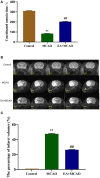Electroacupuncture Ameliorates Cerebral Ischemic Injury by Inhibiting Ferroptosis
- PMID: 33763013
- PMCID: PMC7982901
- DOI: 10.3389/fneur.2021.619043
Electroacupuncture Ameliorates Cerebral Ischemic Injury by Inhibiting Ferroptosis
Abstract
Background: Our previous study found that electroacupuncture (EA) can promote the recovery of neurological functions, reduce the volume of cerebral infarction, and protect the neurovascular unit in middle cerebral artery occlusion (MCAO) rats. Some studies have shown that ferroptosis is closely related to ischemic stroke; however, whether EA plays a protective role by regulating ferroptosis is unknown. Objective: We aimed to investigate the inhibitory effects of EA on ferroptosis in MCAO rats. Methods: We used 36 adult male Sprague-Dawley rats in this study. MCAO rats were established according to the Zea method and treated with EA at a continuous wave of 2/100 Hz and ~2-4 V for 30 min for 7 consecutive days. We analyzed the coordinated motor deficit and volume of cerebral infarction in vivo through 9.4-tesla magnetic resonance imaging. Then, the ischemic brain tissue was isolated and the levels of malondialdehyde (MDA), superoxide dismutase (SOD), glutathione (GSH), and iron were determined. Western blotting and real-time quantitative PCR were performed to evaluate the expression of glutathione peroxidase 4 (GPX4), transferrin (Tf), transferrin receptor 1 (TfR1), and ferritin heavy chain 1 (FTH1). To confirm the results, we used a transmission electron microscope to observe the mitochondrial morphology. Results: EA intervention significantly decreased the oxidative stress level and inhibited ferroptosis. EA significantly improved coordinated motor deficit (P < 0.01) and decreased cerebral infarct volume (P < 0.01) in the EA + MCAO group, compared with the MCAO group. EA downregulated the level of MDA (P < 0.01) and total iron (P < 0.01) and upregulated the level of SOD (P < 0.01) and GSH (P < 0.01) in the EA + MCAO group, compared with the MCAO group. EA increased the levels of GPX4 and GPX4 mRNA (P < 0.01) and FTH1 and FTH1 mRNA (P < 0.05, P < 0.01), whereas it decreased the levels of Tf and Tf mRNA (P < 0.05, P < 0.01) and TfR1 and TfR1 mRNA (P < 0.01) in the EA + MCAO group, compared with the MCAO group. EA also promoted the recovery of mitochondrial morphology according to the mitochondrial classification system for the ischemic cerebral tissue. Conclusion: Our results indicate that EA can inhibit ferroptosis by regulating oxidative stress and iron-related proteins, thus conferring protection against MCAO in a rat model.
Keywords: electroacupuncture; ferroptosis; iron homeostasis; ischemic stroke; mitochondrial.
Copyright © 2021 Li, Li, Dong and Han.
Conflict of interest statement
The authors declare that the research was conducted in the absence of any commercial or financial relationships that could be construed as a potential conflict of interest.
Figures





Similar articles
-
Electroacupuncture Inhibits Ferroptosis by Modulating Iron Metabolism and Oxidative Stress to Alleviate Cerebral Ischemia-Reperfusion Injury.J Mol Neurosci. 2025 May 3;75(2):63. doi: 10.1007/s12031-025-02355-2. J Mol Neurosci. 2025. PMID: 40317390 Free PMC article.
-
Electroacupuncture attenuates ferroptosis by promoting Nrf2 nuclear translocation and activating Nrf2/SLC7A11/GPX4 pathway in ischemic stroke.Chin Med. 2025 Jan 4;20(1):4. doi: 10.1186/s13020-024-01047-0. Chin Med. 2025. PMID: 39755657 Free PMC article.
-
[Effect of "Xingnao Kaiqiao" needling on expression of ferroptosis-related factors in rats with cerebral ischemia-reperfusion injury].Zhen Ci Yan Jiu. 2024 Oct 25;49(10):1019-1029. doi: 10.13702/j.1000-0607.20240279. Zhen Ci Yan Jiu. 2024. PMID: 39433362 Chinese.
-
[Effect of electroacupuncture pretreatment on ferroptosis in neurons of rats with cerebral ischemia-reperfusion injury].Zhen Ci Yan Jiu. 2023 Aug 25;48(8):754-63. doi: 10.13702/j.1000-0607.20230148. Zhen Ci Yan Jiu. 2023. PMID: 37614133 Chinese.
-
Electroacupuncture Inhibits Ferroptosis Induced by Cerebral Ischemiareperfusion.Curr Neurovasc Res. 2023;20(3):346-353. doi: 10.2174/1567202620666230623153728. Curr Neurovasc Res. 2023. PMID: 37357521
Cited by
-
Effect of Electroacupuncture on Short-Chain Fatty Acids in Peripheral Blood after Middle Cerebral Artery Occlusion/Reperfusion in Rats Based on Gas Chromatography-Mass Spectrometry.Mediators Inflamm. 2022 Aug 23;2022:3997947. doi: 10.1155/2022/3997947. eCollection 2022. Mediators Inflamm. 2022. PMID: 36052308 Free PMC article.
-
Trends and hotspots in acupuncture treatment of rat models of stroke: a bibliometric analysis from 2004 to 2023.Front Neurosci. 2024 Apr 24;18:1383283. doi: 10.3389/fnins.2024.1383283. eCollection 2024. Front Neurosci. 2024. PMID: 38721046 Free PMC article. Review.
-
Multicenter Validation of lncRNA and Target mRNA Diagnostic and Prognostic Biomarkers of Acute Ischemic Stroke From Peripheral Blood Leukocytes.J Am Heart Assoc. 2024 Jul 16;13(14):e034764. doi: 10.1161/JAHA.124.034764. Epub 2024 Jul 9. J Am Heart Assoc. 2024. PMID: 38979813 Free PMC article.
-
Role of Ferroptosis in Stroke.Cell Mol Neurobiol. 2023 Jan;43(1):205-222. doi: 10.1007/s10571-022-01196-6. Epub 2022 Jan 31. Cell Mol Neurobiol. 2023. PMID: 35102454 Free PMC article. Review.
-
Neuroprotective effects of electroacupuncture in ischemic stroke: from mechanisms to clinical implications.Front Aging Neurosci. 2025 Apr 24;17:1562925. doi: 10.3389/fnagi.2025.1562925. eCollection 2025. Front Aging Neurosci. 2025. PMID: 40353059 Free PMC article. Review.
References
LinkOut - more resources
Full Text Sources
Other Literature Sources
Miscellaneous

